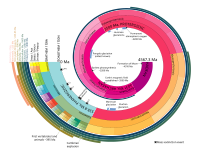Geologic timescale

Okay kiddo, picture this. You know how your mommy and daddy have old photo albums that show how they looked when they were younger? Well, the Earth has an old photo album too, except instead of pictures of people, it's pictures of the Earth's history!
The geologic timescale is like a timeline that shows all the different things that have happened on Earth, but instead of days or weeks, it's divided into a really, really long time. We're talking millions and millions of years!
So let's start at the beginning. You know how you've learned about dinosaurs? Dinosaurs lived a really long time ago, about 65 million years ago, and that's just a tiny, tiny part of the geologic timescale.
The geologic timescale is divided up into different sections called eras, and within those eras, we have periods. Think of it like chapters in a book! For example, we have the Mesozoic era, which is where the dinosaurs lived, and within that era, we have the Jurassic period, the Triassic period, and the Cretaceous period.
These eras and periods aren't just made up randomly though. Scientists have studied rocks and fossils and have come up with a way to group them into different times in history. So it's like a big puzzle that scientists are trying to figure out!
Now, you might be wondering why we even need the geologic timescale. Well, it helps us understand how things have changed over time. For example, we can see how the Earth's climate has changed, or how different animals and plants evolved. It helps us understand our world better and can even give us clues about what might happen in the future.
So there you have it, kiddo. The geologic timescale is like a really long timeline that shows us all the different things that have happened on Earth over millions of years. It helps us understand our world better and is kind of like a big puzzle that scientists are still trying to figure out!
The geologic timescale is like a timeline that shows all the different things that have happened on Earth, but instead of days or weeks, it's divided into a really, really long time. We're talking millions and millions of years!
So let's start at the beginning. You know how you've learned about dinosaurs? Dinosaurs lived a really long time ago, about 65 million years ago, and that's just a tiny, tiny part of the geologic timescale.
The geologic timescale is divided up into different sections called eras, and within those eras, we have periods. Think of it like chapters in a book! For example, we have the Mesozoic era, which is where the dinosaurs lived, and within that era, we have the Jurassic period, the Triassic period, and the Cretaceous period.
These eras and periods aren't just made up randomly though. Scientists have studied rocks and fossils and have come up with a way to group them into different times in history. So it's like a big puzzle that scientists are trying to figure out!
Now, you might be wondering why we even need the geologic timescale. Well, it helps us understand how things have changed over time. For example, we can see how the Earth's climate has changed, or how different animals and plants evolved. It helps us understand our world better and can even give us clues about what might happen in the future.
So there you have it, kiddo. The geologic timescale is like a really long timeline that shows us all the different things that have happened on Earth over millions of years. It helps us understand our world better and is kind of like a big puzzle that scientists are still trying to figure out!
Related topics others have asked about:
